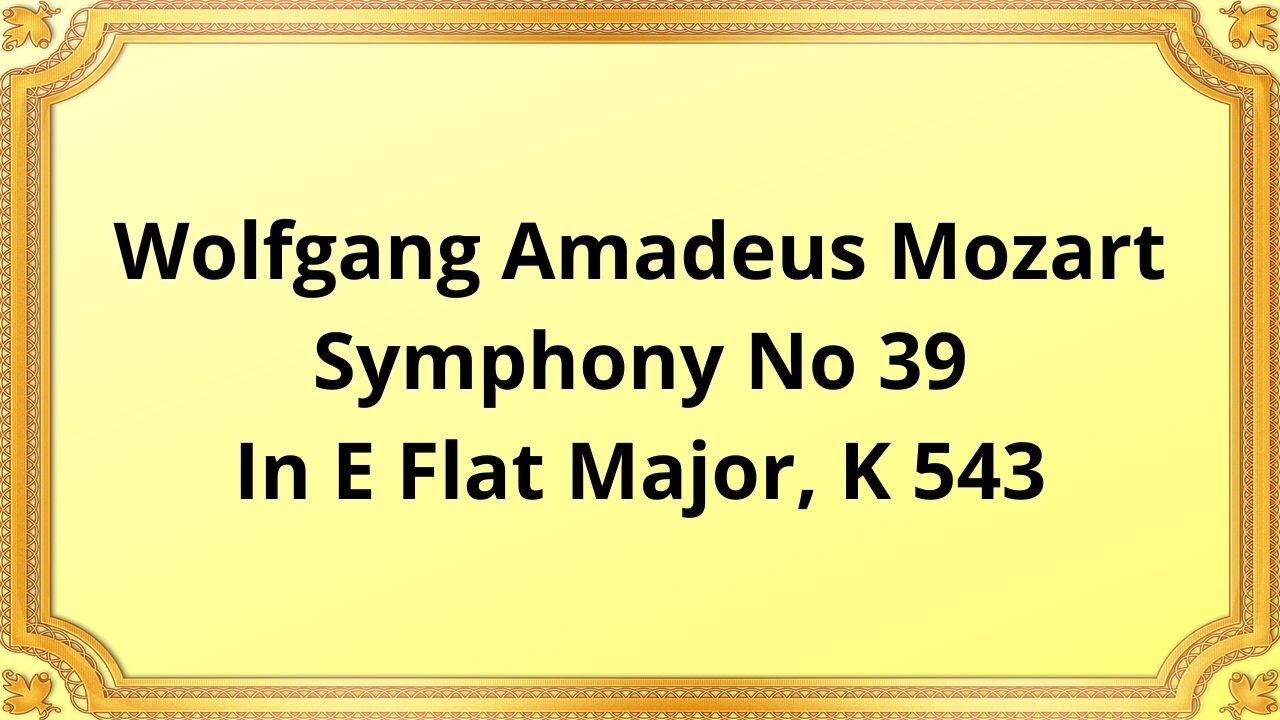Premium Only Content

Wolfgang Amadeus Mozart Symphony No 39 In E Flat Major, K 543
#Mozart#Chamber_music#Classical_music#Symphony#musical_composition
Publication date 1952
The London Symphony Orchestra; Josef Krips
Wolfgang Amadeus Mozart's Symphony No. 39 in E flat major, K. 543 is one of the most popular and beloved symphonies in classical music. Composed in 1788, it was one of Mozart's final three symphonies, all of which he composed within a six-week period. This particular symphony is renowned for its graceful melodies, inventive harmonies, and masterful orchestration, and it continues to be a favorite among both musicians and audiences alike.
Symphony No. 39 is a four-movement work that follows the standard symphonic form of the time. The first movement is in sonata form, with a majestic and imposing opening that sets the tone for the rest of the symphony. The second movement is a slow and expressive adagio, followed by a minuet and trio in the third movement that showcase Mozart's signature elegance and grace. The final movement is a lively and spirited allegro that brings the symphony to a rousing and satisfying conclusion.
One of the most striking characteristics of Symphony No. 39 is its use of orchestration. Mozart was a master of orchestration, and in this symphony, he uses the full range of the orchestra to create a rich and varied sound. The symphony features the standard orchestral instruments of the time, including strings, woodwinds, brass, and percussion, but Mozart also adds clarinets, which were a relatively new addition to the orchestra at the time.
Another hallmark of Symphony No. 39 is its use of melody. Mozart was known for his ability to craft memorable and expressive melodies, and this symphony is no exception. The opening theme of the first movement is majestic and regal, while the second movement features a lyrical and emotional melody that is both beautiful and haunting. The third movement is light and playful, with a charming and memorable melody that is sure to delight listeners.
Symphony No. 39 was composed during a particularly tumultuous time in Mozart's life. He was struggling financially, and his health was beginning to deteriorate. Despite these difficulties, however, Mozart continued to compose at a feverish pace, and the result was one of the greatest periods of creativity in his life. Symphony No. 39, along with his other two final symphonies, marked a turning point in Mozart's career and a culmination of his creative genius.
Conclusion
Wolfgang Amadeus Mozart's Symphony No. 39 in E flat major, K. 543 is a masterpiece of classical music that continues to captivate audiences today. With its graceful melodies, inventive harmonies, and masterful orchestration, it remains one of Mozart's most beloved works
You have the opportunity to support the channel
https://www.donationalerts.com/r/radsiaral
-
 36:29
36:29
Classical music_Music Inspiration
1 month agoAntonín Dvořák Cello Concerto in B minor, Op 104
691 -
 LIVE
LIVE
Glenn Greenwald
2 hours agoThe End to U.S.-Iran War? Iran: Rational Actor or "Death Cult?" Plus: An Israel-First Admission | SYSTEM UPDATE #474
10,773 watching -
 47:41
47:41
Donald Trump Jr.
3 hours agoThe Trump Doctrine & American Strength, All the Latest Breaking News | TRIGGERED Ep.252
27K75 -
 LIVE
LIVE
The Jimmy Dore Show
1 hour agoIran Rocket Attack on U.S. Base in Qatar! Marjorie Taylor Greene RIPS Trump! w/ Dr. Juliette Engel
8,616 watching -
 LIVE
LIVE
RalliedLIVE
1 hour ago $0.19 earnedMonday WZ - Specialist Addict Gets Wins
246 watching -

BonginoReport
2 hours agoAlligator Alcatraz! FL AG Floats Solution To Illegal Alien Crisis - (Ep.75)
29.9K4 -
 LIVE
LIVE
The Mike Schwartz Show
2 hours agoTHE MIKE SCHWARTZ SHOW with DR. MICHAEL J SCHWARTZ
268 watching -
 LIVE
LIVE
SpartakusLIVE
30 minutes agoSpart RETURNS || The Masses REJOICE
20 watching -
 1:05:07
1:05:07
TheCrucible
3 hours agoThe Extravaganza! EP: 09 with Guest Host: Jay Dyer (6/23/25)
66.1K17 -
 1:27:24
1:27:24
Kim Iversen
3 hours agoIsrael Increasingly Isolated — Trump’s "Truce" With Iran Raises New Questions
24.5K65